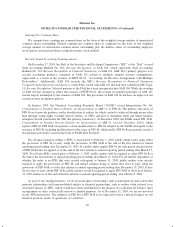Humana 2003 Annual Report Download - page 77
Download and view the complete annual report
Please find page 77 of the 2003 Humana annual report below. You can navigate through the pages in the report by either clicking on the pages listed below, or by using the keyword search tool below to find specific information within the annual report.
Humana Inc.
NOTES TO CONSOLIDATED FINANCIAL STATEMENTS—(Continued)
Earnings Per Common Share
We compute basic earnings per common share on the basis of the weighted average number of unrestricted
common shares outstanding. Diluted earnings per common share is computed on the basis of the weighted
average number of unrestricted common shares outstanding plus the dilutive effect of outstanding employee
stock options and restricted shares using the treasury stock method.
Recently Issued Accounting Pronouncements
On December 17, 2003, the Staff of the Securities and Exchange Commission (“SEC” or the “Staff”) issued
Staff Accounting Bulletin No. 104, Revenue Recognition, or SAB 104, which supercedes Staff Accounting
Bulletin No. 101, Revenue Recognition in Financial Statements, or SAB 101. SAB 104’s primary purpose is to
rescind accounting guidance contained in SAB 101 related to multiple element revenue arrangements,
superceded as a result of the issuance of EITF 00-21, “Accounting for Revenue Arrangements with Multiple
Deliverables.” Additionally, SAB 104 rescinds the SEC’s Revenue Recognition in Financial Statements
Frequently Asked Questions and Answers, or the FAQ, issued with SAB 101 that had been codified in SEC Topic
13, Revenue Recognition. Selected portions of the FAQ have been incorporated into SAB 104. While the wording
of SAB 104 has changed to reflect the issuance of EITF 00-21, the revenue recognition principles of SAB 101
remain largely unchanged by the issuance of SAB 104. The provisions of SAB 104 do not have an impact on our
current revenue recognition policies.
In January 2003, the Financial Accounting Standards Board (“FASB”) issued Interpretation No. 46,
Consolidation of Variable Interest Entities, an Interpretation of ARB 51, or FIN 46. The primary objectives of
FIN 46 are to provide guidance on the identification of entities for which control is achieved through means other
than through voting rights (variable interest entities, or VIEs) and how to determine when and which business
enterprise should consolidate the VIE (the primary beneficiary). In December 2003, the FASB issued FIN 46-R,
Consolidation of Variable Interest Entities—an interpretation of ARB 51 (revised December 2003), which
replaces FIN 46. FIN 46-R incorporates certain modifications to FIN 46 adopted by the FASB subsequent to the
issuance of FIN 46, including modifications to the scope of FIN 46. Additionally, FIN 46-R incorporates much of
the guidance previously issued in the form of FASB Staff Positions.
For all special purpose entities (“SPEs”) created prior to February 1, 2003, public entities must apply either
the provisions of FIN 46 or early adopt the provisions of FIN 46-R at the end of the first interim or annual
reporting period ending after December 15, 2003. If a public entity applies FIN 46 for such period, the provisions
of FIN 46-R must be applied as of the end of the first interim or annual reporting period ending after March 15,
2004. For all non-SPEs created prior to February 1, 2003, public entities will be required to adopt FIN 46-R at
the end of the first interim or annual reporting period ending after March 15, 2004. For all entities (regardless of
whether the entity is an SPE) that were created subsequent to January 31, 2003, public entities were already
required to apply the provisions of FIN 46, and should continue doing so unless they elect to early adopt the
provisions of FIN 46-R as of the first interim or annual reporting period ending after December 15, 2003. If they
do not elect to early adopt FIN 46-R, public entities would be required to apply FIN 46-R to those post-January
31, 2003 entities as of the end of the first interim or annual reporting period ending after March 15, 2004.
As part of our ongoing business, we do not participate or knowingly seek to participate in transactions that
generate relationships with unconsolidated entities or financial partnerships, such as entities often referred to as
structured finance or SPEs, which would have been established for the purpose of facilitating off-balance sheet
arrangements or other contractually narrow or limited purposes. As of December 31, 2003, we are not involved
in any SPE transactions. The adoption of FIN 46 or FIN 46-R is not expected to have a material impact on our
financial position, results of operations, or cash flows.
69
























